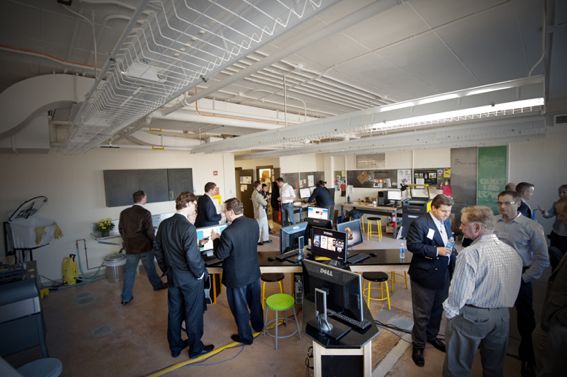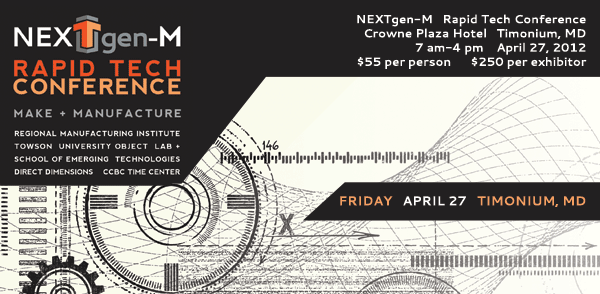
Bryan Sivak, Chief Innovation Officer for the State of Maryland, Professor Jan Baum, Towson University & Dr. Mike Galiazzo, Regional Manufacturing Institute of Maryland
Recently local business leaders and government representatives met to discuss the proliferation of rapid technologies, a mode of manufacturing that’s quickly reshaping the way the world does business. This important conversation was held at the Object Lab, a state-of-the-art, rapid technologies and digital fabrication research facility located at Towson University, led by Professor Jan Baum. Along with Jan Baum, the meeting was hosted by Mike Galiazzo, President of the Regional Manufacturing Institute of Maryland (RMI).
Attendees were invited to see the lab and to discuss rapid technologies and how it will change our world of work, especially advanced manufacturing. All present were speakers or sponsors of the upcoming NEXTgen-M Rapid Tech Conference on April 27 in Timonium, Maryland, hosted by Regional Manufacturing Institute of Maryland, Towson University Object Lab and School of Emerging Technologies, Community College of Baltimore County TIME Center and Direct Dimensions.
“I am thrilled to have this important opportunity to share these technologies first-hand with state and local leaders especially Bryan Sivak, the Chief Innovation Officer for the state of Maryland, and Chris Reith, Deputy of Public Affairs for the Governor’s office. Their engaged interest and critical dialogue is what we need to advance this agenda for the greater Baltimore region.” said Professor Baum.
“This meeting was the beginning of a movement that will answer two questions. How will rapid tech and digital manufacturing shape our region and Who will be involved?” commented, Dr. Mike Galiazzo, Regional Manufacturing Institute of Maryland
“Direct Dimensions is proud to work with Jan and Mike to bring to the region a new movement to advance our 3D industry. We have an outstanding list of speakers for the April 27th Rapid Tech Conference including many people who attended tonight’s meeting.” said Michael Raphael, CEO, Direct Dimensions
Also in attendance were Tom Sadowksi, CEO, Economic Alliance of Greater Baltimore, Dan Gundersen, Director, Baltimore County Economic Development, Jason Hardebeck, CEO, Greater Baltimore Tech Council, Jason Berns, Director of Open Innovation, Under Armour, Michael Raphael, CEO, President, Direct Dimensions Inc., Dean Susan Picinich, College of Fine and Performing Arts, Towson University, John Danko, President, Danko Arlington Foundry, Ernie Brodbeck Jr., Neschen Corporation, Lee Klebe, Engineering Club, Adam Nepp and Scott Wohler, NeWoTechnologies, all of whom are either speakers, sponsors, or supporters of the NEXTgen-M Rapid Tech Conference.

Jason Berns, Director of Innovation at Under Armour, John Danko, Danko Arlington Foundry, and Dan Gundersen, Director, Baltimore County Economic Development
“This is an opportunity to talk about these technologies from a global perspective. We feel that it’s important to explain the point of view that the local and global implications are intertwined. This subject is important and understanding it in all its permeations is important as well.” -Jason Berns, Director of Innovation, Under Armour
The Object Lab was the perfect setting for the first talk in a series of planned “Rapid Tech Talks” among key rapid technology leaders and influencers who are working to advance the rapid technology agenda in the Greater Baltimore Region. Equipped with four different 3d printing technologies and tools to perform 3d laser scanning, 3d computer modeling, reverse engineering and laser cutting, there are few labs in the country that are this comprehensive. The lab is the ideal place to get an up-close look at the future of industry and understand how this technology can create positive economic impact in the near future. The enormous potential for these technologies makes education in the field critical at this juncture, and for this reason we are fortunate to have a world-class facility accessible to local business and the entrepreneurial community in our region. Other local colleges and universities offering rapid tech programs or opportunities include the Community College of Baltimore County, MICA, and UMBC.
“I came to witness the newest forms of rapid prototyping technology, how they are being used in the university setting, and to meet some of the other groups and individuals interested in using these technologies,” said Scott Wohler, CTO and Founder [co-founder] of NeWoTechnologies.
When asked how rapid technologies contributes to NeWo Technologies’ efficiency and overall productivity, Scott explained:
“As a company, we often come up with new concepts for devices and the faster we can get our hands on tangible objects, the sooner we can revise and reshape designs to better fit the needs of the device. Often the design cycle happens in an isolated vacuum, generating data, layouts, design files, etc. while sitting in front of a computer. The customer often doesn’t see anything tangible for a period of time, therefore, it is beneficial in the early stages to show them tangible prototypes to keep them motivated in the design process. In addition, creating prototype enclosures and packaging early can save time and costs – problems can be addressed and changes can be made easily without retooling.”
The difference in efficiency between additive processes, like those employed by 3d printers, compared to subtractive processes, utilized in traditional machining techniques, is staggering. A typical 3d printer works by depositing or solidifying small amounts of material (that is then solidified by either chemical or electrical means) in any number of ways depending on the technology. The term ‘additive manufacturing’ indicates the process of fabricating objects layer by layer. Traditional subtractive methods of manufacturing requires milling components from blocks of raw materials and much of what is removed is wasted.. Overall, the additive process requires less energy, less space, and only uses about 10% of the raw materials consumed by traditional methods.
Though rapid prototyping has become standard across many industries, rapid technologies are being used more and more in the manufacturing of finished products. The uses range from medical implants, lighting, furniture, jewelry, customizable eyewear, and even components used to assemble one-of-a-kind custom motorcycles. Some of the more advanced research being done includes developing methods to print living cells in order to form healthy tissue, and eventually, entire replacement organs.
“Where the divide is going to happen, and soon, is between rapid prototyping and rapid manufacturing. Currently, rapid manufacturing isn’t as efficient but, I think that will change at some point. I think that these technologies are going to be pervasive. You can already purchase small machines for $1200. I’m going to purchase one for my kids. Why wouldn’t I? It’s a great way to interact with the three dimensional world in an entirely different way. I think it’s a really powerful thing.” -Jason Berns, Director of Innovation, Under Armour
On April 27th leaders and learners of the rapid technology movement will be gathering at the NEXTgen-M Rapid Tech Conference at the Crowne Plaza in Timonium, Maryland for the first of a series of conversations about the opportunities and implications of these technologies. Like the Internet, they are a significant component to the digital revolution and will certainly transform life as we know it in the 21st Century. The NEXTgen-M Rapid Tech Conference is a chance to get a first hand look at what the future holds. It’s an opportunity to learn about in what may very well be one of the most significant technological shifts in human history.



